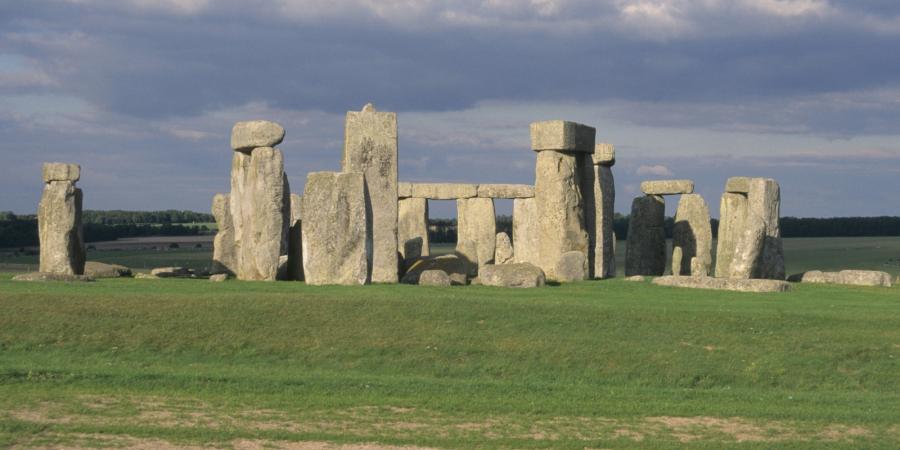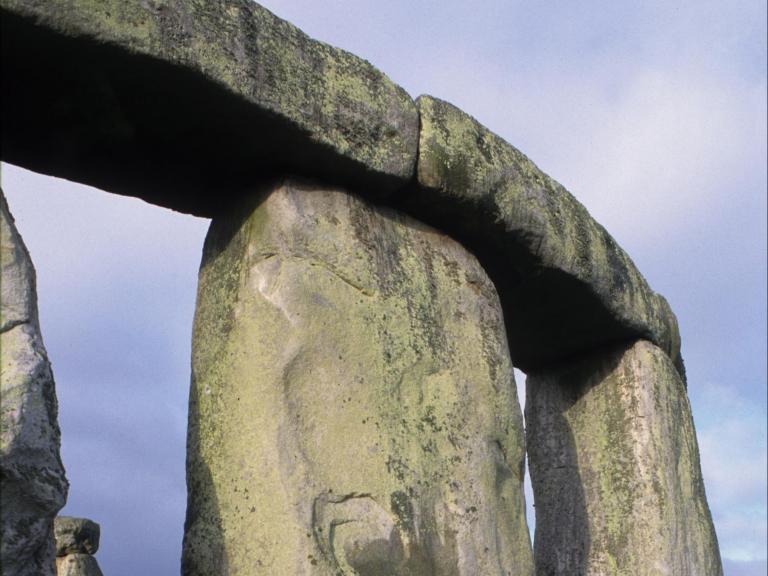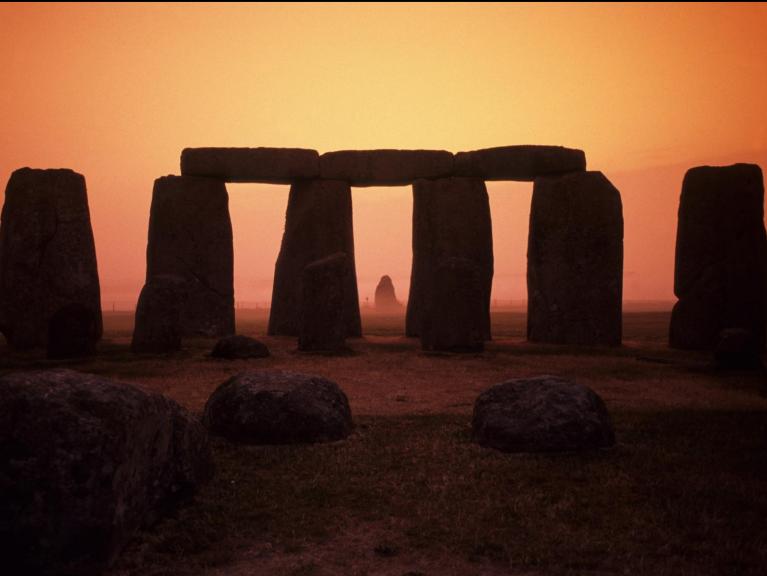51.178882, -1.826215
The megalithic Neolithic henges of Stonehenge and Avebury are among the most iconic and widely-recognised prehistoric monuments in the world. In 1986 the two monuments and the landscapes they occupy were together inscribed by UNESCO as the Stonehenge, Avebury and Associated Sites World Heritage Site (WHS) on account of their Outstanding Universal Value.
Wessex Archaeology is proud to have had a long history of work at both Stonehenge and Avebury, and to have played a leading role in their research, management and investigation. Indeed, since the founding of the Trust for Wessex Archaeology in 1983 our company logo has been the image of a Stonehenge trilithon.
The challenge
The landscapes around Avebury and Stonehenge are of unparalleled archaeological richness and significance, and because of their World Heritage Site status any works undertaken within them come under the closest scrutiny in terms of their research considerations, and their planning, execution, post-excavation analysis and reporting. Over the years Wessex Archaeology has been deeply involved in all these areas of work.
Research
From the earliest antiquarian investigations, the Neolithic and Bronze Age monuments within the World Heritage Site – which include, around Avebury: Silbury Hill, the West Kennet and Beckhampton Avenues, the Sanctuary, the West Kennet Long Barrow and West Kennet palisade enclosures; and around Stonehenge: Robin Hood’s Ball causewayed enclosure, the Stonehenge Avenue, the Cursus, Durrington Walls and Woodhenge, and numerous round barrows cemeteries – have been the object of the most intense archaeological research.
The results of these works, which have often been the test-bed for new techniques of archaeological survey, excavation, and scientific analysis, have played a central role in shaping our understanding of prehistoric society. With their World Heritage Site status it is essential that a systematic approach is taken to collating the ever-growing body of information about them, and formulating strategies that will provide answers to the many questions that remain.
To this end, in 2016, on behalf of Historic England, Wessex Archaeology compiled, edited and published A Research Framework for the Stonehenge, Avebury and Associated Sites World Heritage Site, and authored the first fully integrated Research Agenda and Strategy for the World Heritage Site.
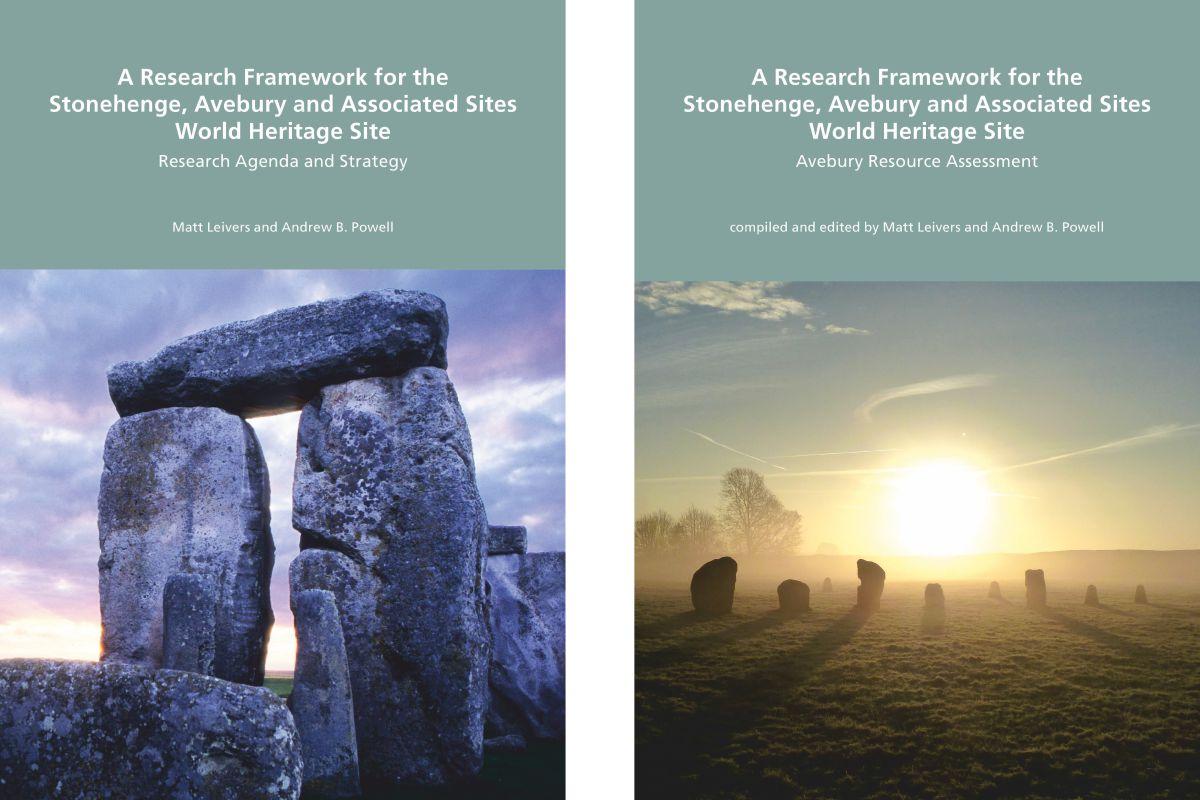
Research framework publications, and an aerial view of Avebury (© Bob Clarke)
Wessex Archaeology has a long involvement in innovative research programmes. These have included the laser scanning of the Stonehenge megaliths to fully reveal the ancient carvings of Bronze Age axes now barely visible to the eye. More recently, we have contributed data to the ground-breaking European-wide ancient DNA (aDNA) study of Bell Beaker populations recently published in Nature and previously our work on the Amesbury Archer and Boscombe Bowmen featured prominently within ground breaking studies of isotopes revealing that individuals had moved great distances within their lifetimes.
Heritage Management
Wessex Archaeology has played an important part in the management of the archaeological resource within the World Heritage Site. In 2002 we undertook the Stonehenge WHS Monument Condition Survey which examined the condition of, and made management recommendations for, over archaeological 660 sites of prehistoric to modern date. Wessex Archaeology has frequently undertaken remedial works at monuments that have been put at risk by agriculture, vegetation or animal activity, like the badgers that had burrowed into barrows at the Winterbourne Stoke roundabout west of Stonehenge.
Fieldwork Archaeology: survey and excavation
Wessex Archaeology has undertaken a wide range fieldwork projects within and around the World Heritage Site, from small local developments to large-scale infrastructure projects, using the full range of survey, evaluation and excavation methodologies, and producing results of prehistoric, Romano-British, Anglo-Saxon, medieval, post-medieval and modern date.
While historically the focus of attention had been on the spectacular prehistoric monuments, much less was known about the contemporary settlements. Therefore, between 1980 and 1984 (The Trust for) Wessex Archaeology undertook The Stonehenge Environs Project, a programme of archaeological investigation involving surface artefact collection, geophysical and geochemical surveys, and sample excavation, in the immediate vicinity of Stonehenge. The aim of the project, for English Heritage, was to identify prehistoric settlements in the area, so leading to strategies for their preservation and management. The Project clearly demonstrated that the Stonehenge landscape was not one reserved for ritual activity.
In the Avebury landscape, in 1989, Wessex Archaeology exposed part of the complex of Late Neolithic timber palisade enclosures at West Kennet, while in 1992 we monitored the replacement of a 4 kilometre sewer pipeline which passed through three Early Bronze Age round barrow ditches, and revealed buildings within the Romano-British roadside settlement next to the Silbury Hill, the tallest prehistoric mound in Europe, as well as Anglo-Saxon features at Avebury itself.
In advance of filming for the BBC series The Manor Reborn, Wessex Archaeology’s Built Heritage team was commissioned by the National Trust, the owners of Avebury Manor, to undertake a programme of historical, archaeological and scientific investigation of the Grade I listed building. The manor house was surveyed using the latest digital survey techniques, the data being recorded as a three-dimensional point cloud collected by laser scanner.
Wessex Archaeology has also played a central role in the Stonehenge Environmental Improvements Project, a programme of works designed to improve the monument’s landscape setting and transform the visitor experience. This included works along the now-decommissioned A4344 road past Stonehenge, involving the excavation of sections through the ditch around the Heel Stone and the Avenue ditches, as well in the area of the new Stonehenge Visitor Centre near Airman’s Corner.
For many years Wessex Archaeology has been called upon to undertake preparatory works related to schemes to relieve the traffic bottleneck where the A303 (part of the main route between London and the south-west of England) passes Stonehenge, and to improve the setting of the monument. In 2008, the results of evaluation works between 1998 and 2003 were published as Archaeology on the A303 Stonehenge Improvement. More recently (and currently in 2018) Wessex Archaeology has undertaken extensive geophysical survey of the route of the present proposals, which involves a tunnel where the road passes the monument, along with large-scale trial trench evaluation. These have revealed previously unknown Neolithic monuments, and other highly significant prehistoric remains.
Wessex Archaeology has also been involved in a number of large-scale fieldwork projects related to housing developments just beyond the boundaries of the World Heritage Site, including those associated with the Army Basing Programme (ABP) which is providing new housing for armed forces personnel returning to the UK from bases abroad. Recent discoveries on ABP sites include a previously unknown Early Neolithic causewayed enclosure at Larkhill, the second such monument within the World Heritage Site, and a pair of small adjacent henges at Bulford, as well as other significant prehistoric features, and Anglo-Saxon cemeteries at Bulford and Tidworth.
Wessex Archaeology’s recent ABP excavations at Larkhill have also thrown a bright light on Salisbury Plain’s role as a military training area, revealing a large array of WWI practice trenches and tunnels where British and Commonwealth soldiers were trained in advance of their mobilisation to the theatre of war. Some of the soldiers left their signatures carved as graffiti into the chalk, allowing them to be identified from documentary records, and their individual stories told. The area was later used to train forces in advance of WWII and even into the 1970s.
Discoveries at the former MOD headquarters at Durrington, have revealed Late Neolithic features including two intersecting posthole alignments, the ditch of a substantial Late Iron Age riverside enclosure, and a Romano-British settlement. Meanwhile, over two decades of excavations on Amesbury Down, south-east of Amesbury, have revealed a large Mesolithic posthole similar to those found in the old carpark at Stonehenge, a Late Neolithic timber circle and post-line, and numerous prehistoric burials of Beaker, Bronze Age and Iron Age date. These include the world-renowned grave of the Amesbury Archer, the richest burial known from this period (c. 2400–1800 BC) ever found in Britain and containing the country’s first gold objects. Amesbury Down was also used as a burial ground in the Romano-British period, as revealed by the excavation of eight separate cemeteries on the site, together containing over 250 inhumation graves and many cremation graves.
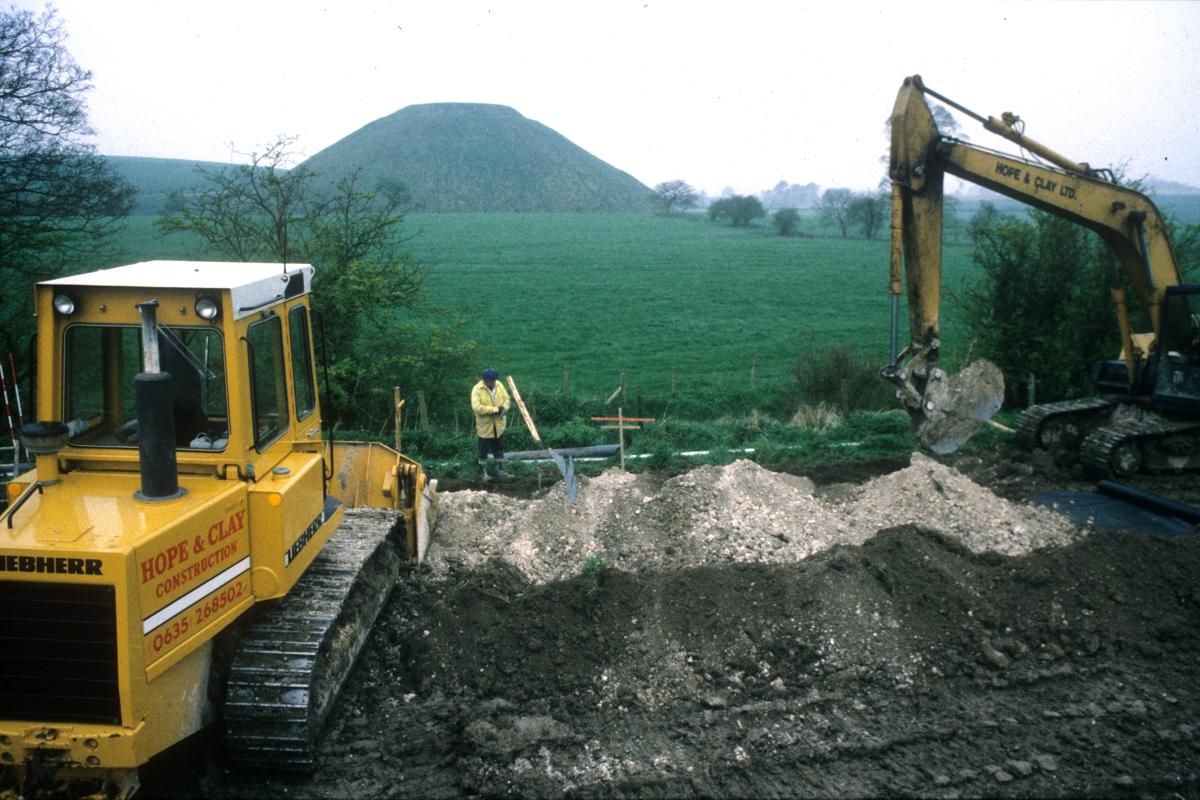
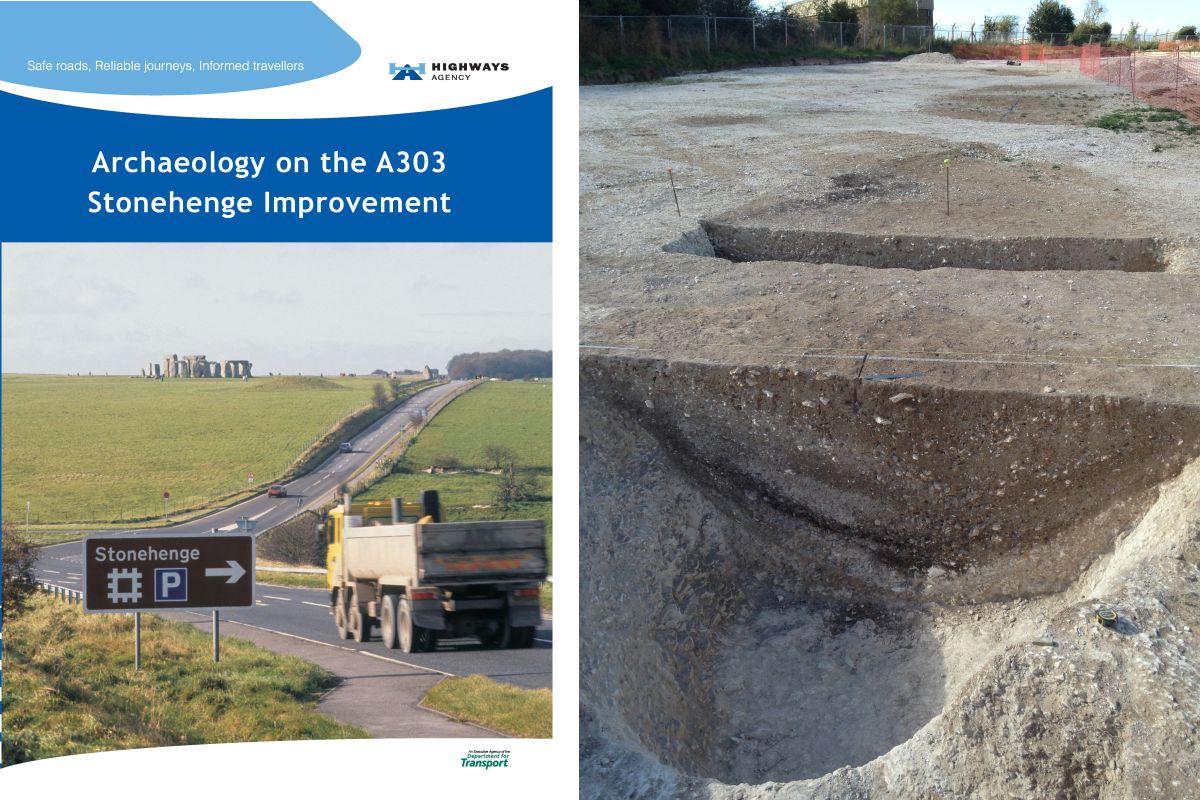
Monitoring a sewer pipeline replacement next to Silbury Hill, the front cover of the 'Archaeology on the A303 Stonehenge Improvement' publication and the Larkhill causewayed enclosure
Analysis and reporting
The many archaeological fieldwork projects, large and small, undertaken by Wessex Archaeology within and around the World Heritage Site have been followed by programmes of detailed post-excavation and/or specialist analysis. As a result we have produced numerous reports, from grey literature reports deposited with the Wiltshire and Swindon Historic Environment Record, to articles published in the Wiltshire Archaeological and Natural History Magazine and other archaeological and specialist journals, as well as in Wessex Archaeology’s own Occasional Paper and Monograph series.
Some of these reports have been on single finds, such as on the giant flint core, believed to date to the Neolithic, found at West Kennet near Avebury, during a field walking exercise, or the decorated chalk plaque found in a Late Neolithic pit on King Barrow Ridge, east of Stonehenge, during the widening of the A303. However, some of the reporting has also had a much wider scope.
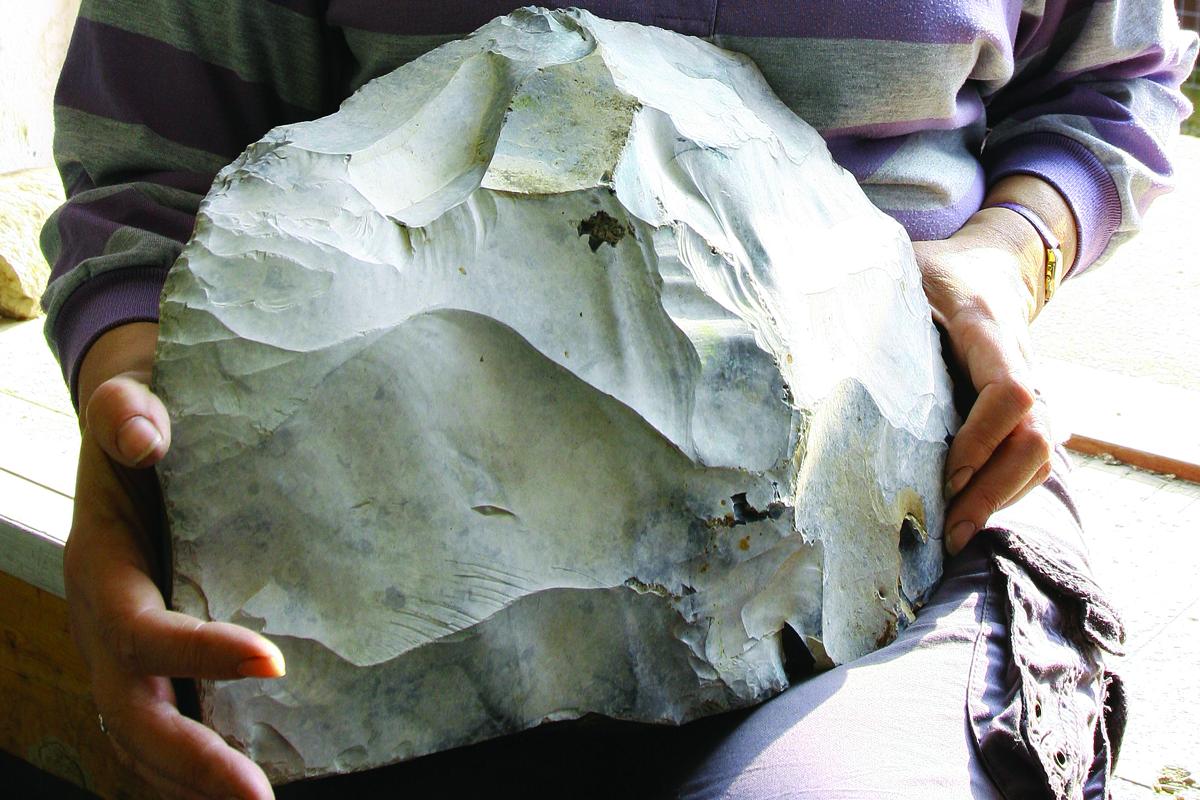
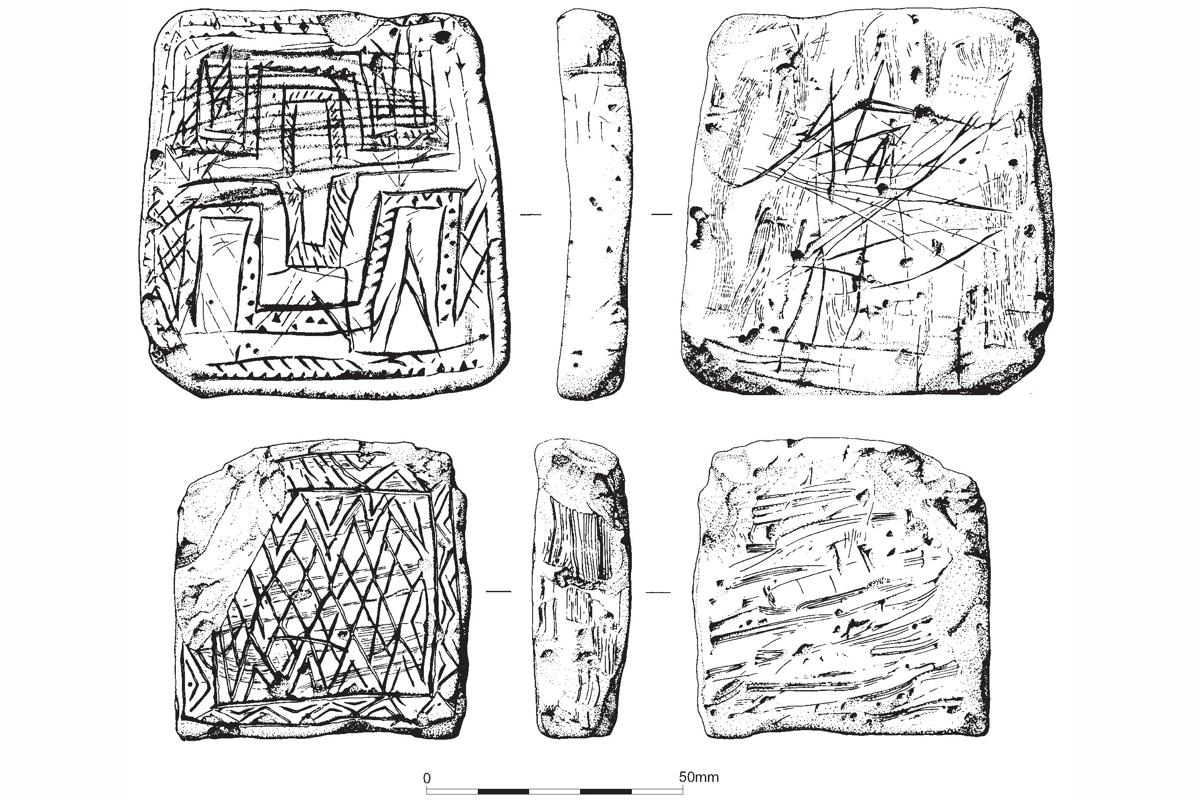
A giant flint core, believed to date to the Neolithic, found at West Kennet near Avebury, and a decorated chalk plaque found in a Late Neolithic pit on King Barrow Ridge
Probably the most important piece of recent post-excavation analysis for the World Heritage Site was undertaken by Wessex Archaeology, resulting in the publication by English Heritage in 1999 of Stonehenge in its Landscape: Twentieth-century excavations. This definitive report provided for the first time a detailed analysis and integration of all the evidence from primary records of the excavations carried out by William Gowland (1901), Lt-Col William Hawley (1919–26); Stuart Piggott and Richard Atkinson with J F Stone (1950–64), so permitting the first comprehensive discussion of the monument’s structural history.
The future
The many projects which over the years Wessex Archaeology has undertaken within the landscape of the Stonehenge, Avebury and Associated Sites World Heritage Site, and at those iconic sites themselves, have made very significant contributions not only to the development of innovative techniques of archaeological investigation and analysis, but more importantly to the increasing academic and public understanding of these world famous monuments. Wessex Archaeology will continue to play a major role in researching this most fascinating of archaeological landscapes.
